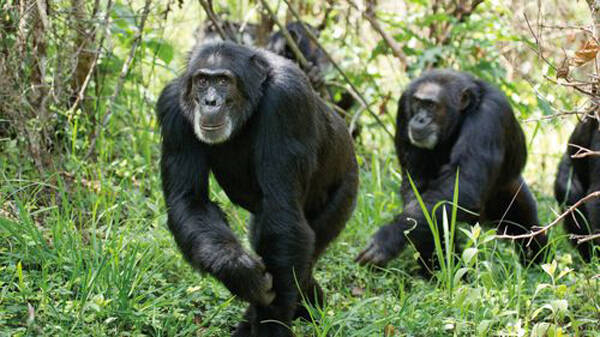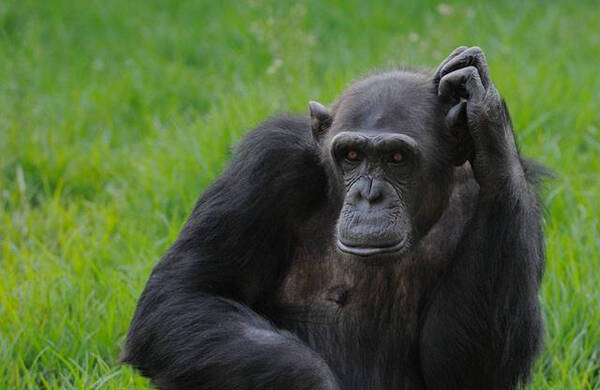Pan troglodytes
IUCN
LCBasic Information
Scientific classification
- name:Pan troglodytes
- Scientific Name:Pan troglodytes,Chimpanzee,gorilla
- Outline:Primates
- Family:Hominidae Chimpanzee
Vital signs
- length:70-140cm
- Weight:45-80kg
- lifetime:About 40 years
Feature
It is the most intelligent animal known after humans.
Distribution and Habitat
Origin: Angola, Burundi, Cameroon, Central African Republic, Congo, Democratic Republic of Congo, Côte d'Ivoire, Equatorial Guinea, Gabon, Ghana, Guinea, Guinea-Bissau, Liberia, Mali, Nigeria, Rwanda, Senegal, Sierra Leone, South Sudan, United Republic of Tanzania, Uganda.
Possibly extinct: Benin, Burkina Faso, Togo.
Regionally extinct: Gambia.
Distributed near the equator in Africa, it lives in tropical hot and humid, low-lying, tall and dense deciduous rain forests, mostly active on the edge of the forest.
Appearance
Chimpanzees are very similar to gorillas in appearance. Due to their short and coarse hair, they are also thin. The males are 110-140 cm long, 1-1.7 meters tall when standing, and weigh 50-80 kg. Females are smaller than males, but the difference between males and females is not as big as that of gorillas. The face is mostly black, but there are also white, flesh-colored and gray-brown. The brow ridge is high, the eyes are deep, the iris is yellow-brown, the mouth is wide, there are 32 teeth, and there are no wrinkles on the enamel molars. Its head is round and flat, without the towering crown pad like that of gorillas. In addition, the nostrils are small and narrow, the lips are long and thin, and there is a pair of large fan-shaped ears on the head, which are also obviously different from gorillas. It has a smaller throat pouch, but no tail, cheek pouches or calluses. The limbs and fingers are very strong. The forelimbs are longer than the hind limbs. The forelimbs can hang slightly
Details
Chimpanzees (scientific name: Pan troglodytes) are called Chimpanzees in foreign languages. There are 4 subspecies. The nominate subspecies is also called the black-faced chimpanzee. It has a lighter face and becomes bald in old age. The male has very little beard. It is found in Congo, Gabon, Cameroon, Nigeria and the Central African Republic. The East African subspecies is also called the long-haired chimpanzee. It has a darker face and thicker hair. It is found in Zaire, Uganda and Tanzania. The West African subspecies is also called the white-faced chimpanzee. It always has a lighter face. Only the forehead becomes bald in old age. The males have beards. It is found in Guinea, Sierra Leone, Liberia, Ivory Coast, Ghana, Togo and other places. However, recent studies have shown that the mitochondrial DNA of the West African subspecies is arranged in a different order from that of other subspecies. Therefore, from the perspective of molecular taxonomy, it should be an independent species.

Chimpanzees like to live in groups. Although their social structure is not as tight as that of gorillas, they are more gregarious than gorillas. The size of the group varies, sometimes 3-5, sometimes up to 30-50. The relationship between group members is relatively loose, especially the sexual relationship is loose. Females can mate with many males, but there are also "love loyalty". The leader is also an adult male animal, and there is a certain hierarchy. Group members give way to the leader, nod, bow, and call softly, and the leader responds by touching hands, touching the head, and other actions. The members of the group often change. When there is an opportunity, they can leave the group and join other groups. Some elderly individuals are often not accepted by any group and have to live alone. Sometimes conflicts occur between different groups, and even cannibalism occurs occasionally. When male animals grow up, they often compete to be the leader, and only those with strong physique can win. However, sometimes the prestige of the new leader has not yet been established, and he still needs to rely on the help of the old leader for a long time.
Chimpanzees are semi-arboreal animals. They are much better at climbing trees than gorillas, but far worse than orangutans. They do not use arm walking to move forward in the forest. They mostly land on all fours on the ground and support themselves with bent knuckles. It is a nomadic animal with a certain range of activities, but its habitat is not fixed and it does not live in one place for a long time. It spends more time underground during the day. It forages in the forest in the morning, and stays in one place to play and rest in the afternoon. It begins to prepare to build a nest, and will interweave large and small branches with leaves and lay them on a tree with lush branches and leaves about 4-5 meters to 30 meters above the ground. At dusk, they go to sleep in the tree and sleep until sunrise the next morning.

Chimpanzees are curious, active, agile and clever. They often gather together during the day to make a lot of noise, which is very chaotic. They make a lot of noise almost every 20 minutes, and often use the dense branches to play games such as "swinging" and "hide and seek".
Chimpanzees can make expressions of joy, anger, sadness, happiness, etc. When they meet, they shout loudly to greet each other. Some of them bow, hold hands, hug, kiss or touch each other's face and neck with their hands. When some individuals are irritable, their companions will put their hands on their shoulders to calm them down. When exchanging ideas and information with each other, they not only rely on different sounds, but also use various postures and gestures to express more complex emotions. For example, when they see ripe fruits on the tree, they will howl loudly to notify their companions to eat; when they are attacked, they will howl in fear or pain to let their companions come to support; when one member of the chimpanzee catches prey, other members will reach out to eat; when they are surprised, they always touch or hug their companions next to them; when they find abundant fruits, they show a happy expression and kiss and hug their companions enthusiastically to express their excitement, etc. Companions often comb each other's hair, scratch each other's itch, catch parasites, etc. to promote emotional communication.
Chimpanzees have a large appetite and spend 5-6 hours a day foraging. The food mainly consists of fruits, fresh leaves, and tender shoots of plants. They also steal bananas and fruits from the fields. In the season when fruits are the most scarce, they also eat insects, small birds, and termites. They even collectively hunt larger animals such as baboons, antelopes, and wild boars. After they pounce on them and kill them, they tear the prey into pieces and share them with the whole group. The use of tools is a phenomenon that exists in many animals, but chimpanzees can give a certain degree of processing to certain tools before using them. Although this processing is extremely simple and crude, it is an active, purposeful, and conscious behavior to transform objects to make them more suitable for use. For example, it can not only use its index finger to poke the ant hole bigger, but also pick up a branch or grass stick, clench its palm to remove the grass leaves, and then put it into the hole to fish out the ants and eat them. If the grass stick is bent, it will bite off the bend or replace it with another one. In addition, it can also use a long wooden stick to beat branches, eat leaves, and use a stick to poke into the beehive to dip honey and eat. What's more amazing is that sometimes it can first put the leaves in its mouth and chew them into a sponge shape, put them into the tree hole where it is difficult to put its mouth into to absorb the accumulated water, and then take them out and put them in its mouth to suck the water. It will even find some herbs to treat gastrointestinal diseases by itself.

Chimpanzees can be in estrus all year round, but are more active in spring and autumn. It is the only ape with periodic skin swelling. The skin of females is very red and swollen during estrus. At the peak of ovulation, the buttocks swell to the maximum extent and appear blister-like. Females give birth to one cub per litter, with a gestation period of about 228 days and a lactation period of about 1 year. After giving birth, the females are very maternal. They often let the young cubs hold their fur and hug them tightly in their arms. When they grow up, they let them ride on their bodies and roam around. The cubs grow rapidly. They grow teeth at 2 months old, can walk upright at 3.5 to 4 months old, can eat fruits by themselves after 4.5 months, and can live independently after 1 year old, but will not separate from the females until they are fully mature. Males reach sexual maturity at 8-10 years old, and females at 6-8 years old, with a lifespan of 35-40 years.
Genome sequencing research has appeared repeatedly in the media, making such figures familiar to the general public: humans share 60% of genetic information with fruit flies, 80% similarity with mice, and about 98.5% similarity with chimpanzees (the genes between the two differ by at most 1.5%, so the similarity between chimpanzees and humans is surprising. In fact, Rh-positive blood types between humans and chimpanzees can be transfused to each other). Just a 1.5% difference determines that one is outside the cage and the other is inside the cage; one hosts the Olympics and the other jumps on trees; one studies the Goldbach conjecture and the other is amazing if he can count to 9; one can grow up to look like Audrey Hepburn and the other is covered with black hair; one talks about "all men are created equal" and the other is tortured in a medical laboratory.

The distribution range of chimpanzees is decreasing year by year, and the total number was estimated at 172,700-299,700 in 2003. There are about 6,400-9,600 East African chimpanzees living in the Democratic Republic of the Congo and about 5,000 in Uganda. The Central African nominate subspecies is estimated to have 70,000-110,000 individuals, and the West African subspecies is estimated to have 70,000-116,500 individuals. Guinea is estimated to have 21,300-55,600 individuals. In the 2006 census, it was found that the subspecies distributed in Nigeria and Kabul had less than 6,500 individuals remaining. The largest number is in Nigeria's Gashaka Gumti National Park, with up to 1,500 individuals.
The habitat and ecology of chimpanzees are in moist and dry forests, mainly along the forest extending to the savanna forest area. They are omnivorous animals, and their diet varies greatly, depending on population and season. Habitat fragmentation and human destruction have caused the habitat environment to deteriorate greatly, which is the main reason for the endangered population of this species. A Spanish committee has submitted an application to the parliament, requesting legislation to protect the survival rights of chimpanzees from being violated by humans. If approved, the world's first chimpanzee protection law will also be born. Achim Steiner, UN Under-Secretary-General and Executive Director of UNEP, said that UNEP will help Congo develop laws, regulations and guidelines on natural environment protection. In addition, the new plan will focus on strengthening anti-poaching operations to prevent the illegal killing of precious apes.
Listed in the 2008 Red List of Endangered Species of the World Conservation Union (IUCN) ver 3.1-Endangered (EN).
Listed in the Appendix I of CITES of the Washington Convention on International Trade in Endangered Species.
Protect wild animals and eliminate game.
Maintaining ecological balance is everyone's responsibility!








